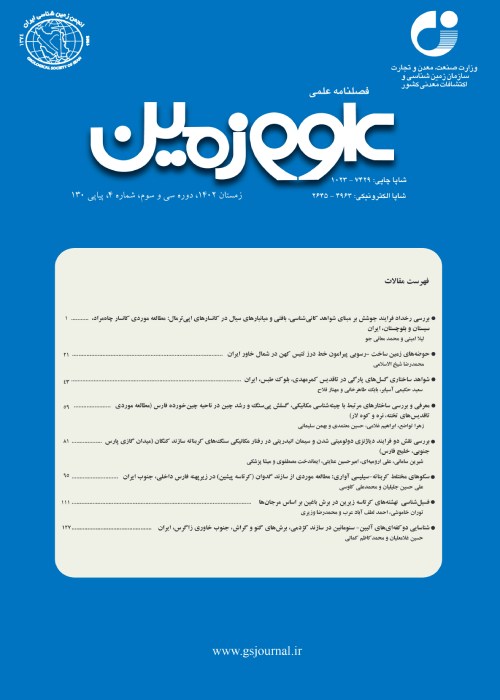Skarn Geochemistry - Mineralogy and Petrology of Source Rock Sangan Iron Mine, Khorasan Razavi, Iran
Author(s):
Abstract:
Sangan Iron ore deposit is located 300 km southeast of Mashhad (Eastern Iran). Based on the high grade, low P- content and big ore reserve, Sangan is an important Iron mine in Iran. It is a magnetite skarn and can be classified as iron-oxide type deposit. Based on the surface exposure, the western magnetite skarn (A´), a Ca-rich type skarn, was formed at the contact of intrusive. Eastward, the skarn gradually becomes distal and Mg-type. The A´ magnetite skarn contains andradite, magnetite, K-rich amphibole, hedenbergite and calcite. Magnetite skarn in A, B, and C- south contain magnetite, repidolite, ferro-actinolite, siderite and minor pyrite. Baghak and C- north magnetite skarn comprise Mg-rich- magnetite, phlogopite, chinochlore, talc, dolomite, forsterite, dolomite, pyrite ± chalcopyrite ± arsenopyrite ± pyrrhotite. High S-content is found mainly in Baghak and C-north deposits. In this research, the igneous source rock is found in A´ deposit and identified as ultra-potassic type (K2O> %9). Sarnowsar granite which used to be the source rock for Iron, contains less than %5 K2O, therefore it cannot be the source. The K2O content of Sarnowsar granite increases near the magnetite skarn due to alteration. The Fe-ore bearing solution moved along the contact between Sarnowsar granite and the limestone. Sarnowsar granite was altered and skarn formed in the limestone. The source rock is quartz biotite-hornblende alkali syenite to quartz hornblende syenite porphyry. The younger intrusive rocks are biotite granite, biotite-hornblende quartz monzonite porphyry and quartz syenite porphyry. Potassium within the ore bearing solution controlled the mineralogy of skarn. Contact skarn in A´ magnetite deposit comprises K-rich amphibole and distal skarn (Baghak and C-north) contains phlogopite. Comparison of trace elements from source rocks with Sarnowsar granite indicates that the Nb, Zr, Zn and Rb contents are high in the former rocks and Cu and Sr ones are higher in the latter rock. Furthermore, comparison of some trace elements from source rocks with younger intrusive rocks indicate that Cr, Ni, Zr, Ce, Cu, Sr, and La contents are higher in younger intrusive and Rb content is higher in source rocks.
Language:
Persian
Published:
Geosciences Scientific Quarterly Journal, Volume:17 Issue: 65, 2007
Page:
108
magiran.com/p509961
دانلود و مطالعه متن این مقاله با یکی از روشهای زیر امکان پذیر است:
اشتراک شخصی
با عضویت و پرداخت آنلاین حق اشتراک یکساله به مبلغ 1,390,000ريال میتوانید 70 عنوان مطلب دانلود کنید!
اشتراک سازمانی
به کتابخانه دانشگاه یا محل کار خود پیشنهاد کنید تا اشتراک سازمانی این پایگاه را برای دسترسی نامحدود همه کاربران به متن مطالب تهیه نمایند!
توجه!
- حق عضویت دریافتی صرف حمایت از نشریات عضو و نگهداری، تکمیل و توسعه مگیران میشود.
- پرداخت حق اشتراک و دانلود مقالات اجازه بازنشر آن در سایر رسانههای چاپی و دیجیتال را به کاربر نمیدهد.
دسترسی سراسری کاربران دانشگاه پیام نور!
اعضای هیئت علمی و دانشجویان دانشگاه پیام نور در سراسر کشور، در صورت ثبت نام با ایمیل دانشگاهی، تا پایان فروردین ماه 1403 به مقالات سایت دسترسی خواهند داشت!
In order to view content subscription is required
Personal subscription
Subscribe magiran.com for 70 € euros via PayPal and download 70 articles during a year.
Organization subscription
Please contact us to subscribe your university or library for unlimited access!


